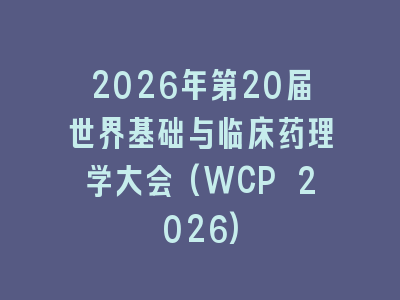|
◆ 会议时间:2026年7月12-17日
◆ 会议地点:澳大利亚 墨尔本
◆ 会议简介:
2026年第20届基础与临床药理学世界大会(WCP2026)将于2026年7月12-17日在澳大利亚墨尔本举行,会议由澳大利亚临床与实验药理学家和毒理学家协会(ASCEPT)与国际基础与临床药理学联合会(IUPHAR)联合举办。
国际基础与临床药理学联合会(IUPHAR)原名为国际药理学联合会,1959年作为国际生理科学联合会的下属机构成立,2006年更名为国际基础与临床药理学联合会。IUPHAR是国际科学理事会(ISC)的科学联盟成员,总部位于瑞士巴塞尔,是一个非营利性组织。IUPHAR的宗旨是通过药理学的教育和研究改善健康状况。IUPHAR的目标是通过以下方式宣促进药理学方面的国际交合作;促进代表全世界药理学和相关学科的学会之间的合作;主办国际性和区域性会议,并通过设立咨询委员会协助其组织工作;遵守国际科学理事会(ISC)条文5有关不分种族、宗教、政治哲学、族裔、国籍、语言或性别的不歧视规定,鼓励国际协作以及科学家间和科研成果的自由交流;作为一个机构,药理学家可以与其他科学的科学家一起直接或在诸如ISC、WTO(世卫组织)和联合国科教文组织(UNESCO)等国际科学机构的支持下参与国际活动;以各种方式帮助全世界药理学的发展,特别是新兴经济体;促进公众对药理学问题的认识。IUPHAR现分为八个学部:药物代谢与药物运输学部(DMDT),教育学部(IUPHAR-ED),胃肠药理学学部(GI),免疫药理学学部(ImmuPhar),天然产物药理学学部(SPNP),神经精神药理学学部(NPP),儿科临床药理学部,遗传药理学和药物基因组学学部(PGx)。未经许可禁止复制摘录转载本站任何内容-领域国际医学会议网。
WCP 2026 – 20th World Congress of Basic and Clinical Pharmacology
Date: 12–17 July 2026
Venue: Melbourne Convention Centre, Australia
Organized by:
Australasian Society of Clinical and Experimental Pharmacologists and Toxicologists(ASCEPT)
International Union of Basic & Clinical Pharmacology (IUPHAR)
摘要征文投稿:
Abstract submission deadline: Monday 15 September 2025
Notification of acceptance/decline: Monday 10 November 2025
点此提交摘要>>>Submit Abstract>>>
- A5 abstract submission template
- Presenter terms and conditions
The Organising Committee reserves the right to accept or decline any submissions and to select the presentation format.
Presenting authors will be notified of their acceptance status on Monday 10 November 2025 and must inform any co-author(s).
Guidelines for abstract submission
1. Requirements for preparation of abstracts
Abstracts submitted for scientific sessions should describe work that has not been published or presented at another national meeting. The selection of contributions for scientific sessions will depend on the quality of the abstract submitted.
2. Title box
Use sentence case, bold, Calibri font 10 point, maximum of 12 words. Concisely encapsulate the work presented in the abstract. Sentence case is when you only capitalise the first letter of the first word in a heading – like you would in a sentence. Proper nouns also have a capital.
3. Authors
Starting on a new line, without a line-space to the Title, list the Presenting Author first, followed by other authors, name only, as directed in the template. Use a mixture of upper and lower case text, e.g., Geoffrey A Harrison, Peter L McCartney & James H Lennon. Do not use ‘bold’ or ‘underline’.
4. Addresses
Include the authors’ Department Name, Organisation, City, State and Country immediately after the names (ie., do not start a new line). Author’s department and institution should be abbreviated. Superscript numbers should be used to link the author(s) to their address(es) presented (e.g. Geoffrey A Harrison1, Peter L McCartney1, 2. Dept of Pharmacol, Univ of Melbourne1, Parkville, VIC; Dept of Clin Pharmacol, Royal Melbourne Hosp2, Parkville, VIC).
5. Text
Leave one line space after the Authors/addresses. Do not indent. Type as one block of text and include sub-headings: Introduction, Aims, Methods, Results and Discussion (including any conclusions drawn from results). Start each heading on a new line with text immediately following heading and without additional line spacing. Headings only should be in bold. If any references are added, include one additional line spacing following the abstract text (see sample of references below). The abstract should be left-and right-justified. The text should be as informative as possible. Statements such as “The results will be discussed” are not acceptable and will likely result in rejection.
6. Units
Concentration – use either molar or mass units as most appropriate: nmol/L, μmol/L, mmol/L, etc.; or: ng/L, µg/L, mg/L, etc.
Dose – use mg/kg, or mmol/kg, etc.
Dose schedules – use mg/kg per day, or mmol/kg per day etc.
Pressure – may be in mmHg, psi, Pascal, or Torr, etc, as appropriate.
Tension – may be in “g”, etc.
7. Anaesthetic
If an anaesthetic is used, it must be named along with the dose and route of administration.
8. Figures and tables
One figure or table is allowed per abstract; these should not contain a separate written title or legend, and the table should not contain any vertical lines. Abstracts will be printed in black and white only, therefore it is preferrable that you use greyscale images.
9. Statistics
Use the format: mean±SEM (n= ; P<) e.g. 57±3 (n = 7, P<0.02). If ± is used to indicate anything other than a standard error, e.g., a range or standard deviation, this should be specified in the abstract. Where appropriate, authors should ensure consistency in the number of decimal places used.
10. References
In the text, citations should appear as first author plus et al (if multiple authors) followed by year (eg., Medic et al, 2010). The listed references after the text of the abstract are to be shown in alphabetical order of first author. They should include authors’ last names followed by initials (use “et al” for three or more authors), year of publication (in brackets), the title of the journal (abbreviated in accordance with Index Medicus), volume number, and the first and last page numbers. References to articles in books should consist of the names of authors, year of publication, title of the book, the editors, page numbers, place of publication and the publishers. Example: Jagger MS et al (2010) Br J Clin Pharmacol 33:56-61.
11. Standard abbreviations
Excessive use of abbreviations should be avoided. All abbreviations should be defined when they are first used, except for the following standard abbreviations:
Acetylcholine Ach
Adrenaline Ad
G-aminobutyric acid GABA
Area under curve AUC
Blood Pressure BP
Bovine serum albumin BSA
Cardiovascular system CVS
Celsius oC
Central nervous system CNS
Clearance CL
Confidence interval CI
Correlation coefficient r
Dalton Da
Degrees of freedom d.f.
Deoxyribonucleic acid DNA
Diameter, inside i.d.
Diameter outside o.d.
Enzyme linked immunosorbent assay ELISA
Gas chromatography-mass spectroscopy GCMS
Gas-liquid chromatography GLC
Glomerular filtration rate GFR
Gram g
Half life t1/2
Hertz Hz
High performance liquid chromatography HPLC
Hour(s) h
5-hydroxytryptamine 5HT
Inhibitory constant Ki
International unit iu
Intra-arterial ia
Intracerebroventricular icv
Intraperitoneal ip
Intravenous iv
Liquid chromatography-mass spectrometry LC-MS
Litre L
Mass Spectrometry MS
Metre m
Michaelis constant Km
Minute min
Molar concentration M
Noradrenaline NA
Optical rotation (+)(-)
Oral po
Pharmacodynamic PD
Pharmacogenetic/genomic PG
Pharmacokinetic PK
Probability P
Radioimmunoassay RIA
Radiolabel (e.g. tritium) [3H]
Second s
Standard Deviation SD
Standard Error of the Mean SEM
Single Nucleotide Polymorphism SNP
Subcutaneous sc
Tandem mass spectrometry MSMS
Ultraviolet uv
Volume of Distribution V
Presentation types
Oral presentations – 10 minutes duration with 5 minutes for questions
Poster presentations
- Format: A0 size (841mm x 1189mm or 33.1 × 46.8 inches), portrait orientation
- Display: Hard copy, printed (may be laminated or on fabric)
- Presenters must be available at their poster during a specified time
Kindly refrain from submitting the same abstract for both oral and poster presentations.
Abstract submission themes
| Congress themes |
IUPHAR sections & committees |
Drug Discovery
Novel Approach Methodologies and Quantitation (inc. mRNA, Biologics, Natural products)
Infectious diseases |
Basic and Translational – including but not limited to Natural Products, Transparency & Reproducibility, Cancer |
| Gastro-intestinal/Urogenital |
Basic and Translational – Gastro-intestinal |
| Respiratory and Inflammation |
Basic and Translational – Immunopharmacology |
| Cardiovascular |
Basic and Translational – Cardiovascular |
| Neuropharmacology |
Basic and Translational – Neuropsychopharmacology |
Drug Disposition and Response
Toxicology
Regulatory Science
Pharmacoepidemiology
Innovation & Industry |
Clinical and Translational |
| Global Health |
Clinical and Translational – Global Health Pharmacology and Therapeutics |
| Clinical Pharmacology |
Clinical and Translational – Geriatric |
| Clinical Pharmacology |
Clinical and Translational – Paediatric |
| Pharmacogenomics |
Clinical and Translational – Pharmacogenetics, Drug metabolism and Transporters |
| Education |
IUPHAR – Education |
Abstract format
- Abstract title must not exceed 12 words.
- Abstracts must be submitted via the online abstract submission site.
- Abstracts must be submitted on the A5 word template.
- Do not change the page margins or any set up features.
- The abstract must fit within the space on the template provided (no specific word limit). This includes a figure or table, title, authors and any references.
- The abstract must be one page only.
- The abstract should be typed in 10 point Calibri font (do not use “bold” type)
- All text, including the heading, should be entered in sentence case (do not type in CAPITAL LETTERS)
Welcome
On behalf of the Organising Committee and the Australasian Society of Clinical and Experimental Pharmacologists and Toxicologists we are delighted to invite you to the 20th World Congress of Basic and Clinical Pharmacology 2026 (WCP2026).
From 12–17 July 2026, we will welcome the world’s pharmacology and therapeutics community to the Melbourne Convention Centre in Melbourne/Narrm, Australia. We look forward to celebrating the diversity of this community including students, early career pharmacologists, global leaders in clinical pharmacology, and innovators at the cutting edge of drug discovery and development, innovation and engagement with the pharmaceutical industry and academic sectors.
Melbourne/Narrm, is undisputedly the cultural capital of Australia where creativity and innovation come together to deliver great events, inspiring places to explore and cutting-edge advancements that are globally acclaimed. An ideal destination where the world’s brightest minds gather to inspire, innovate and create real change in world-leading research and development.
The WCP2026 leadership group and local organising committee recognise that the diversity and inclusivity within the global pharmacology community is a strength. As such, the composition of our committees, scientific programmes and the make-up of its attendees, will be guided by our Equity Diversity and Inclusion (EDI) policy. We will actively collect and report on EDI metrics as we develop the program and deliver the conference. We look forward to welcoming speakers and chairs, and attendees across the world to the congress.
Professor Carl Kirkpatrick
|






















